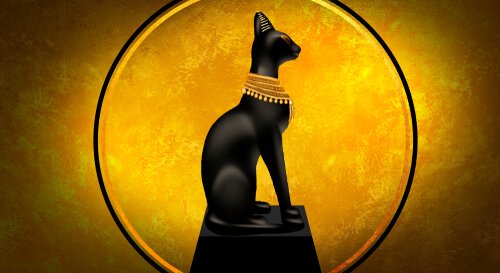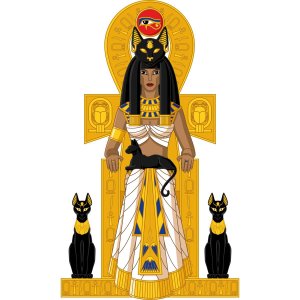The History of Cats in Ancient Egypt

Human beings have admired, and have been mystified and intrigued by cats almost since history began. Dating back to the times before Christ, specifically about 3600 years ago, cats in Ancient Egypt were especially relevant.
At that time, there were only four animals kept as pets: the cat or miu, the dog or tysem, the baboon or ian and the monkey or ky.
Characteristics of cats in Ancient Egypt
Different experts believe that the cat breed the Egyptians domesticated was a spotted subspecies of the African wild cat, Felis silvestris lybica. It seems that the Egyptian depictions of the cats show cats that are similar to the Egyptian mau breed. And, interestingly, the work ‘mau‘ in Egyptian means ‘cat.’
This breed has a characteristic ‘M’ on its forehead and is the only one with natural spots. They’re characterized by their great fidelity, shown both to their human family as well as their cat family. They show their affection with their melodious meowing and by incessantly moving their tails.
This cat was a large part of many aspects of Egyptian life. For example, they played a role in the religion, mythology and daily life of the Egyptians. In all of these aspects, cats were ‘worshipped like deities, loved as pets, protected by the law, mummified and missed after their death,’ according to the October 2009 UBER Magazine.
Lifestyle
The cat was domesticated and then became part of Egyptians’ lives in the Middle Kingdom. The Middle Kingdom is the most prosperous period in Ancient Egypt’s history, when Pharaohs such as Amenhotep III (about 1390-1353 BC) were ruling. Pharaoh Amenotep III had a beautifully decorated sarcophagus for his cat Tamit, whose name means ‘cat.’

The cats fulfilled different duties, like controlling the plagues that proliferated near the Egyptians’ homes. Rats were usually the main cause of these plagues, as well as other animals like scorpions and snakes.
Other tasks also included helping their owners hunt. They scared the birds, which would take off flying, therefore making the hunting work easier. Their work was so important that they became the favorite pet of royalty.
Their role in Egyptian daily life
Cats in Ancient Egypt acquired a relevant role in the different branches of Egyptian culture, like religion and mythology. For example, the goddess Bast, Bastet or Ubastet represented the protection of man, as well as a cat with its young.
Her best-known depiction is one in which her body is that of a human woman, but with the head of a cat. The goddess Bast was the mother of Nefer-Tmu. While the mother represented the soft and comforting warmth of the sun, the daughter personifies the sun itself and its warmth.
Cats were sacred creatures and the Egyptians associated them with the goddess Bastet. In this goddess’ temples, they bred and protected cats. However, they usually sacrificed and mummified them when they were 10 months old as offerings for pilgrims or other individuals.

Interesting facts
In Ancient Egypt, there were plenty of other interesting things going on with cats. Among them, the following stand out:
- When the pet died, the owners expressed their pain and grief by waxing a part of their body. If the deceased pet was a cat, the owner would shave his eyebrows. However, if the pet was a dog, the owner would shave his entire body.
- The wealthiest classes sometimes paid to have their cats embalmed.
- The Egyptians forbade the export of cats outside of the kingdom. Even so, cats had made their way to Greece by 2500 BC.
- Cats were part of numerous stories, legends and literary novels.
- In a legend, the Egyptians depict that cat as a divinity, as the god of the sun. This god-cat is standing on a celestial tree and cutting a snake. Experts don’t know enough to figure out what the cat represents, so they consider different options.
- A study suggested that the populations of eastern Europe also lived with cats. Archaeologists found a double grave of a human and a cat. They were buried in the Mediterranean island of Cyprus 9500 years ago.
Since they began to be part of humans’ lives, cats have generated mixed feelings. Their independence can create indifference towards them. Likewise, their stealthy and elegant gait can cause concern in those who don’t hear them approaching. However, their transparent gaze, lovely purr and overall elegance are qualities that everyone can appreciate.
Human beings have admired, and have been mystified and intrigued by cats almost since history began. Dating back to the times before Christ, specifically about 3600 years ago, cats in Ancient Egypt were especially relevant.
At that time, there were only four animals kept as pets: the cat or miu, the dog or tysem, the baboon or ian and the monkey or ky.
Characteristics of cats in Ancient Egypt
Different experts believe that the cat breed the Egyptians domesticated was a spotted subspecies of the African wild cat, Felis silvestris lybica. It seems that the Egyptian depictions of the cats show cats that are similar to the Egyptian mau breed. And, interestingly, the work ‘mau‘ in Egyptian means ‘cat.’
This breed has a characteristic ‘M’ on its forehead and is the only one with natural spots. They’re characterized by their great fidelity, shown both to their human family as well as their cat family. They show their affection with their melodious meowing and by incessantly moving their tails.
This cat was a large part of many aspects of Egyptian life. For example, they played a role in the religion, mythology and daily life of the Egyptians. In all of these aspects, cats were ‘worshipped like deities, loved as pets, protected by the law, mummified and missed after their death,’ according to the October 2009 UBER Magazine.
Lifestyle
The cat was domesticated and then became part of Egyptians’ lives in the Middle Kingdom. The Middle Kingdom is the most prosperous period in Ancient Egypt’s history, when Pharaohs such as Amenhotep III (about 1390-1353 BC) were ruling. Pharaoh Amenotep III had a beautifully decorated sarcophagus for his cat Tamit, whose name means ‘cat.’

The cats fulfilled different duties, like controlling the plagues that proliferated near the Egyptians’ homes. Rats were usually the main cause of these plagues, as well as other animals like scorpions and snakes.
Other tasks also included helping their owners hunt. They scared the birds, which would take off flying, therefore making the hunting work easier. Their work was so important that they became the favorite pet of royalty.
Their role in Egyptian daily life
Cats in Ancient Egypt acquired a relevant role in the different branches of Egyptian culture, like religion and mythology. For example, the goddess Bast, Bastet or Ubastet represented the protection of man, as well as a cat with its young.
Her best-known depiction is one in which her body is that of a human woman, but with the head of a cat. The goddess Bast was the mother of Nefer-Tmu. While the mother represented the soft and comforting warmth of the sun, the daughter personifies the sun itself and its warmth.
Cats were sacred creatures and the Egyptians associated them with the goddess Bastet. In this goddess’ temples, they bred and protected cats. However, they usually sacrificed and mummified them when they were 10 months old as offerings for pilgrims or other individuals.

Interesting facts
In Ancient Egypt, there were plenty of other interesting things going on with cats. Among them, the following stand out:
- When the pet died, the owners expressed their pain and grief by waxing a part of their body. If the deceased pet was a cat, the owner would shave his eyebrows. However, if the pet was a dog, the owner would shave his entire body.
- The wealthiest classes sometimes paid to have their cats embalmed.
- The Egyptians forbade the export of cats outside of the kingdom. Even so, cats had made their way to Greece by 2500 BC.
- Cats were part of numerous stories, legends and literary novels.
- In a legend, the Egyptians depict that cat as a divinity, as the god of the sun. This god-cat is standing on a celestial tree and cutting a snake. Experts don’t know enough to figure out what the cat represents, so they consider different options.
- A study suggested that the populations of eastern Europe also lived with cats. Archaeologists found a double grave of a human and a cat. They were buried in the Mediterranean island of Cyprus 9500 years ago.
Since they began to be part of humans’ lives, cats have generated mixed feelings. Their independence can create indifference towards them. Likewise, their stealthy and elegant gait can cause concern in those who don’t hear them approaching. However, their transparent gaze, lovely purr and overall elegance are qualities that everyone can appreciate.
All cited sources were thoroughly reviewed by our team to ensure their quality, reliability, currency, and validity. The bibliography of this article was considered reliable and of academic or scientific accuracy.
- Bullón, C. R. (2018). Breve historia de la vida cotidiana del Antiguo Egipto. Ediciones Nowtilus S.L. Online: [https://books.google.es/books?id=FfxQDwAAQBAJ&pg=PT172&dq=los+gatos+en+el+antiguo+egipto&hl=es&sa=X&ved=0ahUKEwjzrNqyj4fhAhUuDWMBHdXqAF0Q6AEILTAB#v=onepage&q=gatos%20&f=false]
- Driscoll, C. A., Clutton-brock, J., Kitchener, A. C., & Brien, S. J. O. (2018). The Taming of the Cat, 300(6), 68–75.
- Budge, E. a W. (2011). El Libro Egipcio De Los Muertos / Book of Coming Forth by Day: El Pairo De Ani, Del Museo Britanico. Editorial Kier. Online: [https://books.google.es/books?id=YNBZwLticRQC&printsec=frontcover&dq=gatos+y+diosa+bastet&hl=es&sa=X&ved=0ahUKEwimiaee7IzhAhXQ1-AKHZcJD7kQ6AEIKDAA#v=onepage&q=bast&f=false]
-
Eason, C. (2009). Nuevos Misterios del Antiguo Egipto. Ediciones Robinbook. Online: [https://books.google.es/books?id=A-Kw5pRpvScC&pg=PA161&dq=los+gatos+en+el+antiguo+egipto&hl=es&sa=X&ved=0ahUKEwjzrNqyj4fhAhUuDWMBHdXqAF0Q6AEITDAH#v=onepage&q=gatos&f=false]
-
Metz, G. (2011). Razas de gatos. Editorial HISPANO EUROPEA. Online: [https://books.google.es/books?id=KxcFJUsjyMIC&pg=PA54&dq=mau+egipcio&hl=es&sa=X&ved=0ahUKEwiC16z2847hAhX9BGMBHSeuACYQ6AEILDAB#v=onepage&q=mau%20egipcio&f=false]
-
This text is provided for informational purposes only and does not replace consultation with a professional. If in doubt, consult your specialist.








